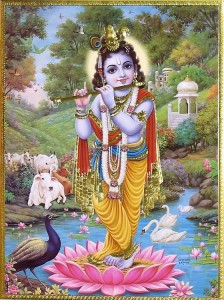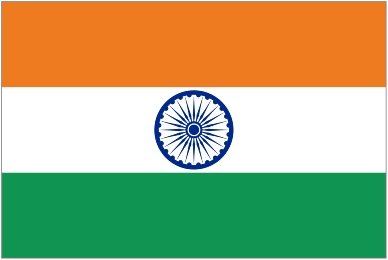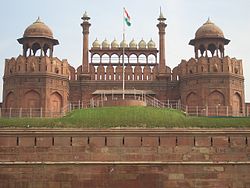August 21-22, 2011
In the house of Vasudeva will the Supreme Lord, the original transcendental person, personally appear…
Bhagavata Purana, 1:23
After midnight, we’re gonna let it all hang down.
Eric Clapton, After Midnight
Though worshipped differently across many Hindu sects, Krishna is one of the holiest figures–if not the holiest–in the Hindu religion. He was born at midnight on this, the eighth day after the full moon of Bhadrapada/Shravan, in the year–well, before you were born.
In 2010 Sri Krishna Jayanti, or Krishna Janmashtami, falls on September 1 or 2, depending on location.
Krishna is considered the eighth and greatest incarnation of the god Vishnu. In art, he’s commonly pictured as a baby or as a youngster playing the flute. Krishna means “black”, but he’s more often depicted as blue.
Before Krishna was born, a prophecy was told to the King Kamsa. That he–the king–would be killed by his cousin’s son. Kamsa placed his cousin Devaki and her husband Vasudeva in prison. Every son that Devaki bore, Kamsa had killed. Six children in all. The seventh boy, Balarama, was magically transfered to the womb of another woman. The eighth child Vasudeva managed to sneak out of the prison. The boy was Krishna. Vasudeva encountered a cow-herding couple who had just given birth to a daughter. They switched babies and Vasudeva returned to the prison, showing Kamsa that the child was a girl, not a boy.
Krishna grew up with the humble cow-herding family. He was a mischievous kid, known for playing pranks and for seducing women with the romantic music of his flute.
When the King heard of Krishna’s existence he invited Krishna to a wrestling match, set up to trap and kill Krishna and his elder brother Balarama. The brothers foiled King Kamsa’s plans, defeating first a mighty demon elephant and the King’s best wrestlers.
When the King drew his sword, Krishna grabbed him by the hair and crushed him to death, fulfilling the prophecy.
The holiday comes to a climax at midnight tonight, when Krishna was said to have been born. Krishna is worshipped through the chanting of Vedic hymns, and mantapam structures built in his honor are decorated with thindis snacks and fruits…
After midnight, it’s all gonna be peaches and cream.
— Eric Clapton






